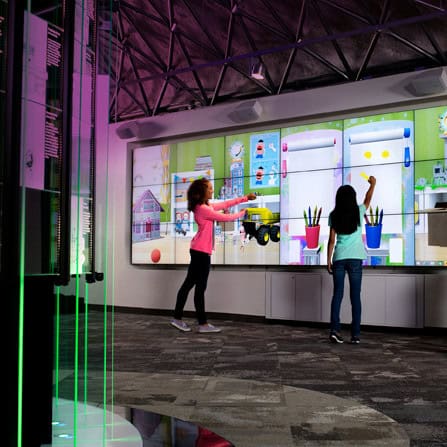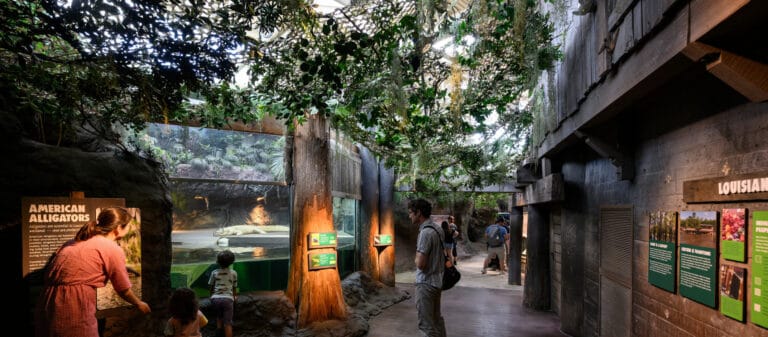How do you tell your story? With words? Pictures?
Or maybe the space around you? Experiential design is a type of design that weaves together storytelling and one’s environment. Defining this type of design can feel challenging because it leaves a lot of room for interpretation, and can be used in a variety of settings.
For example, you might see this type of design in museums, parks, hospitals, and universities. All of these settings are drastically different but can employ aspects of experiential design to help improve experiences. For instance, a hospital can use art, gardens, and soundproofing to reduce the stress experienced by people that walk through their doors.
Museums can combine augmented reality with experiential design to enhance the learning experiences of their visitors. However, this doesn’t quite lend to the unique aspects of experiential design.
Have you ever walked into a space and instantly known what the company or the story it represented was all about? If you have, you have experienced experiential design.
Are you interested in getting involved in this progressive industry and creating memorable experiences that focus on engaging your audience?
Keep reading to learn five ways you can join the world of experiential design.
1. Visit Different Installations and Exhibits That Involve Aspects of Experiential Design
One of the easiest ways to immerse oneself in experiential design is by visiting exhibits and installations that utilize aspects of experiential design. Museums and art galleries are facing a lot of competition today.
Why go somewhere where you only look at a static display when you can choose to experience history or art? New types of art galleries and museums are popping up everywhere that advertise unforgettable experiences.
Going to a regular museum a couple of times, where you get to explore the exhibits, is a great learning opportunity. However, it’s the experiential displays that keep people coming back. These allow you to interact with the exhibit on a new level.
2. Take a Design Class
If you want to get really hands-on, taking a class is the perfect solution. Check your local colleges and see if they offer art or design courses.
This will allow you to learn about the type of design you’re interested in and get some practice with it. You can also look online for free courses.
If you can’t find free courses online or courses at your local college, look for online degree programs that offer classes. It could open up a whole new career option for you.
3. Talk to the Experts
Do you want to learn more about experiential design, but you’re not sure you want to invest in a class? While visiting an art gallery or a museum to see this style of design is an option, it can leave something to be desired if you want a deeper knowledge of how it works.
Here’s the good news; there are tons of people involved in experiential design already who are willing to share their knowledge. Take the time to talk to an expert.
Setting up a time to ask questions with an expert is a great way to grow your knowledge and find out if you want to explore the topic further. You could visit a local studio or send an email with questions. In addition, you could also talk to the experts at 1220.
We can provide a wealth of information about the industry and some of the ins and outs of design.
4. Join a Design Community
If you live in a big city with a lot of artists and designers, finding a design community might be easier. If that’s the case, you can find people to shadow and help you grow your knowledge.
However, people in small rural towns are not geographically limited anymore. In addition, people who can’t get involved in local groups aren’t limited either.
One of the perks of the digital age is there are online communities for everything. Finding online design communities can help you learn more about experiential design and other types of design. In addition, communities allow you to meet other people with the same interests and varying experience levels.
You can talk to a range of people and share ideas and thoughts without ever leaving your home. This is a great way to begin networking if you want a future in design.
5. Support Local Artists
If you’re not interested in being a designer but are fascinated by the end product, you can get involved in the world of experiential design by supporting local artists. Go to exhibits, museums, and studios in your area that frequently show off the work of local artists.
Invite your friends. Become a patron of the arts. There is a need for people who are willing to support the work of local artists.
Without that support, these artists cannot continue creating the stunning displays that people fall in love with and visit over and over again.
Join the World of Experiential Design
There are many ways you can get involved in the world of experiential design. You can take classes, talk to experts, go to museums, support local artists, and more.
You don’t have to be a professional to get involved in this unique world of design. Are you ready to become more involved in experiential design?
Start learning more about 1220’s designs and our experts by exploring our website. In addition, if you’re a designer and interested in joining our team, let’s get connected.









